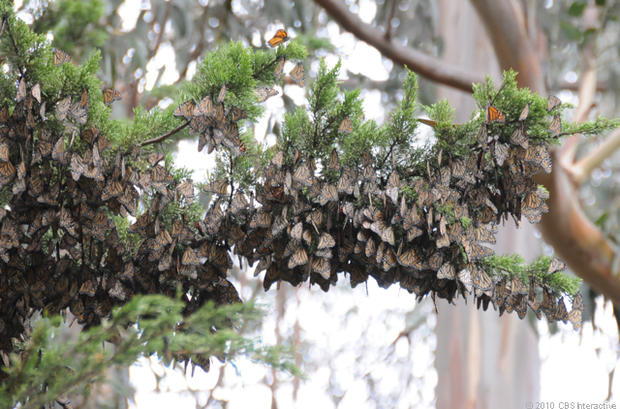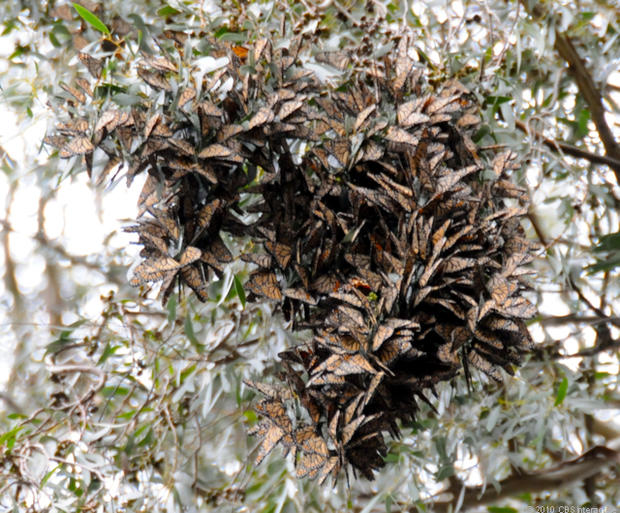Monarch Butterflies Face Population Crisis
SANTA CRUZ, Calif.--When I lived in this beach town on the central California coast in the early 1990s, I loved visiting a stunning local state park where each winter you could find more than 120,000 monarch butterflies swarming, clustering, and flying everywhere you looked.
It was an awesome sight.
Today, a visit to the monarch grove at Natural Bridges State Beach reveals a much grimmer situation--just 2,000 monarchs during the peak of their "overwintering" season, the period from late October through early March when the colorful butterflies rest in the trees here, protected from the cold, rain, and wind, waiting for mating season in the early spring.
And the same bleak picture is being painted in nearby Pacific Grove, Calif., a tiny town adjacent to Monterey that is known as "Butterfly Town, USA," Where once many tens of thousands of monarchs would spend each winter, there are now less than 5,000. And that's up a tick from last year."The big picture is that the monarch populations have precipitously dropped since the 1970s, '80s, and '90s," said Mia Monroe, a monarch expert with the international insect conservation group, The Xerces Society. "And needless to say, we're all worried and concerned and are asking why."
What's happened during the last 15 or so years then is nothing short of a crisis for these beautiful creatures. The rapid depletion of the annual coastal monarch population is a direct reflection, experts say, of the impact of humans on nature. Monarchs must lay their eggs on the milkweed plant, which is gradually disappearing in crucial parts of California as housing subdivisions replace the orchards, meadows, and vacant lots where the plant once proliferated, and as more efficient farming methods have allowed people to grow crops at the margins of their properties, places where milkweed used to thrive.
As well, the increasing use of pesticides in rural areas and water shortages have also threatened monarch habitat. Taken with the marked reduction in milkweed, it's a trifecta that means that a once-exciting visit to Natural Bridges or Pacific Grove is now a much more somber experience.
"Monarchs seem to have sufficient suitable habitat for overwintering along the California coast," said Francis Villablanca, an associate professor in the biological sciences department at California Polytechnic State University at San Luis Obispo. "We have not seen any significant mortality factors associated with overwintering. Therefore, the problem must be with the source of overwintering monarchs, which are the milkweed plants scattered throughout the interior West."
That means, the experts say, that action is required. If there are to be significant winter monarch populations in coastal California in the future, people must be proactive in recognizing the crisis and in doing something about it.
Fortunately, some are heeding the call. An organization called Monarch Watch has launched a campaign called Bring Back the Monarchs, which aims to educate the public about the crisis and what can be done.
"The goals of this program are to restore 19 milkweed species, used by monarch caterpillars as food, to their native ranges throughout the United States," the project's Web site reads, "and to encourage the planting of nectar-producing native flowers that support adult monarchs and other pollinators."
That's a sentiment that Monroe shares. While she's obviously deeply worried about the monarchs, she also sees signs of hope. For one, she said, the 2010 monarch population is up a bit from a year earlier--though still an order of magnitude smaller than in the early 1990s--and at the same time, she feels empowered by the fact that people have an opportunity to recognize and do something about the problem, at least in California--namely, to plant milkweed.
Supergeneration
In the warmer months of the year, monarchs are able to get by on the plentiful milkweed supply of the northern U.S. and Canada. But in winter, the cold climate forces them as much as 2,000 miles south. Those that begin their journey east of the Rocky Mountains are thought to head toward southern Mexico, and westerners embark for coastal California.
According to Monroe, most monarchs have a total life expectancy--including their time in the egg, as a caterpillar, and in their chrysalis--of between six weeks and two months. In their butterfly stage, they tend to live about a month to six weeks. That means that new generations of monarchs are coming along constantly, and leads to one of the most enduring mysteries of their species--how do brand-new butterflies know to return to the same overwintering spots as their ancestors?
"It is the search for proper survival conditions that direct a new generation of monarchs back to an overwintering site," reads a Natural Bridges monarch brochure. "There is still much speculation about how the monarchs return to the same overwintering grounds. The Earth's magnetic field, the position of the sun and geographic features of the land are components of navigation likely to be involved in the mystery."
Perhaps equally impressive is the tenacity of what Monroe called the "supergeneration" of monarchs, those that live a good six to nine months in their overwintering spots in preparation for spring mating season.
Overwintering
If you've never visited a monarch grove before, you might have trouble spotting the clusters of butterflies at first.
That's because, rather than there being large numbers of monarchs sporting their loud orange colors, they actually tend to bunch together in such a way that it's very difficult to distinguish them from the leaves of the trees upon which they gather.
"Monarchs have trouble flying in temperatures under 55 degrees Fahrenheit," reads a Pacific Grove monarch sanctuary brochure. "The butterflies hang in clusters in the trees, resembling dead leaves, until the sunlight warms them. Then they spread their wings and begin to flutter down from the trees."
And why do these thousands of butterflies come to Pacific Grove and Santa Cruz--as well as in smaller numbers in northern California counties like Marin and Sonoma and Southern California counties like Los Angeles and San Diego? The answer, according to the Pacific Grove brochure, is that the fog-shrouded Monterey Pine forest of Pacific Grove [provides] the 'microclimate' they need: proper humidity, light, shade, temperature, and protection from the wind."
At the same time, the emergence of Australian eucalyptus has helped overwintering patterns in Pacific Grove and Santa Cruz "by providing a tree that is not only well-suited to sheltering monarch clusters, but additionally, provides the butterflies with a convenient nectar source since it blooms in winter."
And, explained Monroe, many of the overwintering sites are on protected land, either public parks like Natural Bridges, or public-private sanctuaries like in Pacific Grove.
Inspires Awe
Since I no longer live in Santa Cruz, I'm not able to return to the monarch groves more than once every few years. And that meant that on my recent visit, as part of my Road Trip at Home series, I was shocked by how few butterflies were in evidence at Natural Bridges.
Clearly, I had reason to be alarmed--a notion shared by experts like Monroe.
But it was also instructive to talk to her, since despite what is clearly a catastrophic decline in the numbers of monarchs that can be found in coastal California, Monroe remains bullish on the species' future prospects.
"I guess I feel optimistic, because for once, there's something we can do to be helpful, which is to plant milkweed," Monroe said. "We have the chance to plant milkweed and ask our friends to do that too."
She pointed to the work of MonarchWatch, which is making it easy for people to order the plant and which is working hard to spread the word about the dire circumstances.
But the monarch's lovely colors and patterns may also aid their recovery, Monroe suggested.
"Monarch butterflies inspire awe in us," she said. "They're beautiful and there's the hopeful story of metamorphosis. We all wish to grow and change ourselves [like a] butterfly. And they're easy for us to identify...So if there's something to be hopeful about, it's monarch butterflies."
This article originally appeared on CNET


